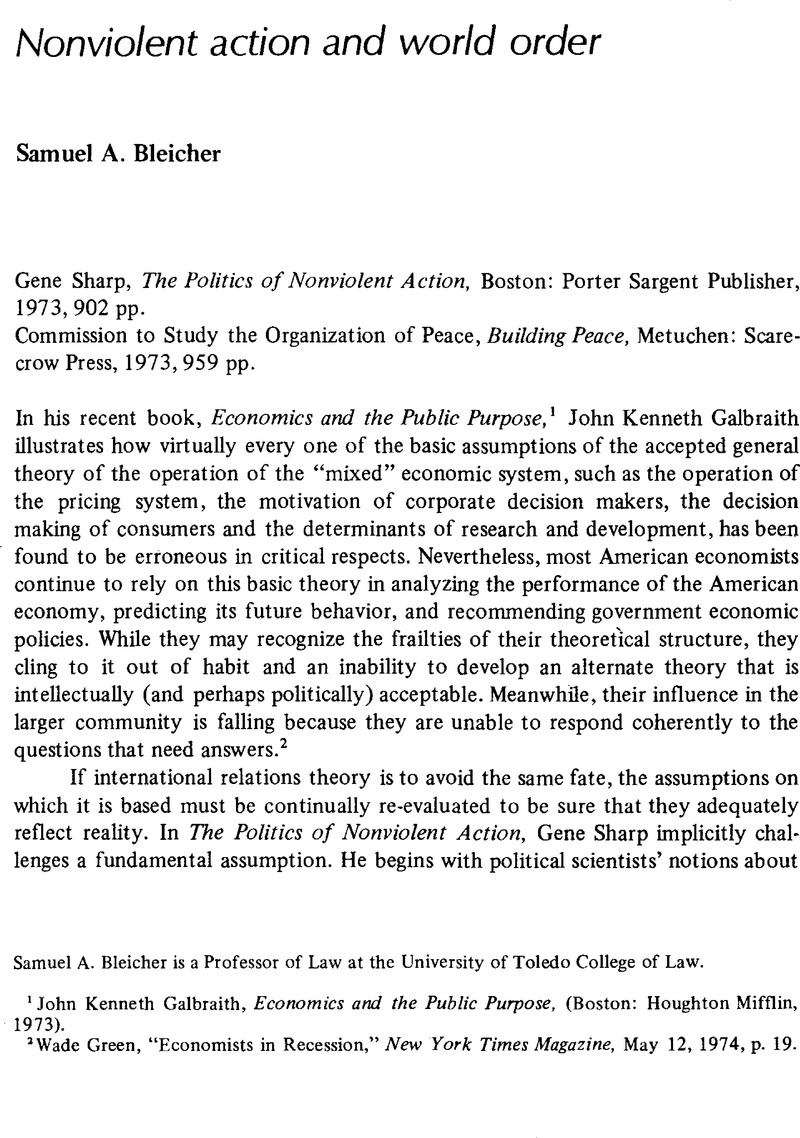Article contents
Nonviolent action and world order
Published online by Cambridge University Press: 22 May 2009
Abstract

- Type
- Review Essays
- Information
- Copyright
- Copyright © The IO Foundation 1975
References
1 Galbraith, John Kenneth, Economics and the Public Purpose, (Boston: Houghton Mifflin, 1973).Google Scholar
2 Green, Wade, “Economists in Recession,” New York Times Magazine, 05 12, 1974, p. 19.Google Scholar
3 See, for example, Keohane, Robert O. and Nye, Joseph S., Transnational Relations and World Politics, (Cambridge, Mass.: Harvard University Press, 1972).CrossRefGoogle Scholar
4 Sharp, Gene, The Politics of Nonviolent Action, (Boston: Porter Sargent, 1973), p. 9.Google Scholar
5 Sharp, p. 19, citing John Austin.
6 Sharp, pp. 3–4.
7 Sharp, pp. 667–75.
8 Schelling, Thomas C.'s Introduction to Sharp, p. xxi.Google Scholar
9 Sharp, pp. 71–74.
10 Sharp, p. 9.
11 Sharp, p. 9.
12 Banco Nacional de Cuba v. Sabbatino, 376 U.S. 398 (1964), in particular pp. 427–37Google Scholar. Also see Falk, Richard, The Aftermath of Sabbatino, (Dobbs Ferry: Oceana Publications, 1965).Google Scholar
13 Reparation for Injuries Suffered in the Service of the United Nations, Advisory Opinion: I.C.J. Reports 1949, p. 174, 178–80. See also Chiu, Hungdah, The Capacity of International Organizations to Conclude Treaties, and the Special Legal Aspects of the Treaties So Concluded, (The Hague: Martinus Nijhoff, 1966).Google Scholar
14 Commission to Study the Organization of Peace, Building Peace, (Metuchen: Scarecrow Press, 1973), pp. 7–8.Google Scholar
15 Ibid., pp. 5–6.
16 Forest Grieves, Supranationalism and International Adjudication, (Urbana: University of Illinois Press, 1969), pp. 82–110.Google Scholar
17 United Nations Charter, Article 43.
18 See, for example, the Report of the Special Committee on Peace-Keeping Operations, UN General Assembly Document A/8888 (13 November 1972).
19 Kristol, Irving, “Where Have All the Gunboats Gone?”, Wall Street Journal, December 13, 1973, p. 18.Google Scholar
20 United Nations Charter Article 2, Paragraph 7.
21 Falk, Richard, ed., The Vietnam War and International Law, vol. I, (Princeton: Princeton University Press, 1968).CrossRefGoogle Scholar
22 Vagts, Detlev, “The Logan Act: Paper Tiger or Sleeping Giant,” American Journal of International Law, vol. 60, April, 1966, pp. 268–302. Professor Vagts raises serious questions about the Constitutional validity of the Logan Act in its present form.CrossRefGoogle Scholar
23 Newsweek, 05 20, 1974, p. 56.Google Scholar
24 Commission, p. 75.
25 Commission, p. 709.
26 For Security Council Deliberations, Article 32 of the UN Charter provides that “Any Member of the United Nations which is not a member of the Security Council or any state which is not a Member of the United Nations, if it is a party to a dispute under consideration by the Security Council, shall be invited to participate, without vote, in discussions relating to the dispute.” This provision has generated a controversy over the applicability of the term “state” to the “Republic of Indonesia,” whose independence from the “United States of Indonesia” was challenged by the Netherlands. See Repertory of Practice of United Nations Organs, vol. 2, pp. 175–77, New York: United Nations, 1955Google Scholar. Article 71 of the Charter provides for limited participation by non-governmental organizations in the UN Economic and Social Council.
27 Article 41: “The Security Council may decide what measures not involving the use of armed force are to be employed to give effect to its decisions, and it may call upon the Members of the United Nations to apply such measures. These may include complete or partial interruption of economic relations and of rail, sea, air, postal, telegraphic, radio, and means of communication, and the severence of diplomatic relations.”
Article 42: “Should the Security Council consider that measures provided for in Article 41 would be inadequate or have proved to be inadequate, it may take such action by air, sea, or land forces as may be necessary to maintain or restore international peace and security. Such action may include demonstrations, blockade, and other operations by air, sea, or land forces of Members of the United Nations.”
28 F., Rita and Taubenfeld, Howard J., “The ‘Economic Weapon’: The League and the United Nations,” American Society of International Law Proceedings, vol. 58, 1964, pp. 183–205.Google Scholar
- 1
- Cited by


